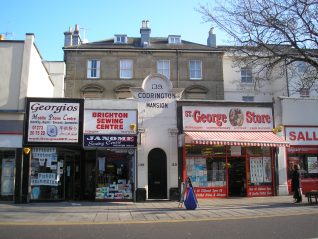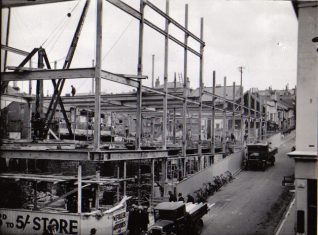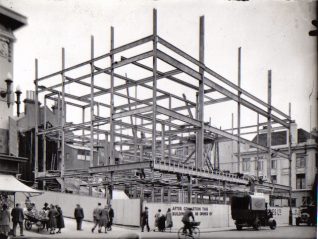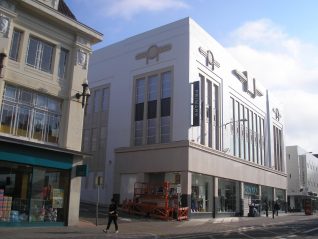Early 20th century redevelopment





Western Road has been the main shopping thoroughfare in Brighton for well over 100 years and it’s almost 200 years since the first commercial activities started in the vicinity. The area was originally called West Laine, and what was to become Western Road was just a path leading from Brighthelstone to the parish church at nearby Hove. The name Western Road originates from the Western family who owned much of the surrounding land.
Growth and grandeur
The growth of Brighton, due to its increased popularity following the patronage by Prince Regent, pushed development outside the original boundary of East, West and North Streets. As housing development spread from the seafront northwards so did shops and businesses. The first commercial activities taking place in Western Road in the early 1800’s. By 1830 its importance was established as the main access road to the new Brunswick Estate. Although at this time there was a mix of commercial and residential properties, by the 1870’s the residential housing had mostly been replaced by shops, which in many cases had been built on the gardens of the original housing.
Gardens
Gardens with frontage onto the north side of Western Road still remained right up to the early 1900’s, however soon after the turn of the century commercialisation of Western Road was complete, and just a few “green” areas remained.
Piecemeal development
Over the previous 100 years Western Road had evolved rather than being planned. Although the south side was quite regular in its alignment, the north side was very irregular. Between the Clock Tower and Montpelier Road there were 8 different widths of road. Most narrow was the Clock Tower end and the stretch between Spring Street and Hampton Place. It was reported that in places the road was so narrow that it was difficult for vehicles to pass.
Pre WWI development
For some years the Town Council had been purchasing properties in congested areas of Western Road and letting them until the leases had expired. In 1906 the large gardens in front of Codrington Place (between Hampton Place and Montpelier Road) were removed in this manner to allow the widening of one of the narrowest parts of Western Road. Remnants of the old residential properties can still be seen here. By looking above the shops, the original grand housing can be still be seen, the shops now built on what was once part of the garden, which originally came much further forward. CodringtonMansion is of this type, built in about 1830, it was the home of Admiral Sir Edward Codrington, who captained HMS Orion in the Battle of Trafalgar in 1805.
Post WWI redevelopment
Following World War One many areas of Brighton were redeveloped. It was due to the forethought of Alderman Sir Herbert Carden that many of these schemes happened. Although the 1920’s and 1930’s redevelopment of the north side of Western Road can’t directly be attributed to Herbert Carden, he was undoubtley the catalyst for such developments in many areas of Brighton.
North side development chronology
The first of these developments started in 1923, Smithers’ Brewery was demolished to make way for the Imperial Arcade. This was followed by Staffords departmental store in 1926, which was the first large departmental store in Western Road, Poundland and the Co-operative Bank currently occupy this site. The eastern corner of Staffords can just be seen in the 1931 photo of British Home Stores under construction, and the same torchlights can still be recognised today. Further westwards the new Boots store was next in 1928. It was built on the site of the previous old Boots store between Spring Street and Crown Street. Wades store was also built in 1928, which was clearly a busy time for redevelopment. Johnson’s the furnishers had traded from Western Road since the very early 1900’s, they celebrated 25 years of trading by rebuilding their store in 1929. Woolworths expanded their premises shortly afterwards. British Home Stores was next in 1931. These unique photographs show the new BHS development in progress between Crown Street and Marlborough Street. The building was taken over in the late 1960’s by C & A when BHS moved to their new premises in Churchill Square, however following refurbishment it is now home to Primark.
75 years of Marks & Spencers
The Marks & Spencers building was next in 1932, and the frontage still remains much as it was when first built. Marks & Spencers are probably the longest surviving business in Western Road, still operating from the same building, having now been there 75 years! The area between the Imperial Arcade and Clock Tower end of Western Road was next in 1934. This area was made up of many small businesses including a Public House and the last remaining private dwellings all clustered together. A number of fine photographs have been published showing the demolition in progress. Lastly in 1935 Mitre House, opposite the top of Preston Street was built. This consisted of a grocery store for International Stores on the ground floor with offices and flats above. Later the ground floor became the prestigious showroom for Jaguar cars.
South side development
The development of the north side was now complete, with mainly large stores all along that side. Plans to redevelop the south side were considered and although some slum clearance was started, the outbreak of World War II put a halt to grand ideas. Following the war, due to a shortage of building materials development could not be restarted and it was not until 1959 that the plans were back on the council agenda. However it was almost 10 years before finally in 1968 that Churchill Square was formally opened.




Comments about this page
I well remember Staffords before the war. On the first floor there was a tea room with a small dance floor and a small five or six piece band that used to play. My mother used to take me there sometimes for tea in the morning. Oh happy days!
This is an excellent piece! However a couple of points to make. M&S were at a different address from 1911 -1932(?); it was west of Regent Hill almost next to Woolworths, they moved eastward in 1932 and expanded further in 1936. In the 19th Century Western Road only applied to one portion, there were I think 3 separate stretches of the road (but see Tim Carder’s ‘Encyclopedia of Brighton’ -as ever). The Corporation were buying stretches of the north side from 1902 onwards as there was concern over traffic congestion! It is a curious fact that most businesses that relocate in Western Road invariably locate east of their initial location – BHS, M&S, Boots, Next, Debenhams etc. The pull of the Central Business District!
Further to my memory of Staffords, I remember Wades and their annual Christmas toy fair, Woolworths – nothing over six-pence, Marks & Spencer – nothing over five shillings, and the side entrance came out into the Arcade and Hamleys toy shop. In the window was displayed the latest Hornby train, the ‘Princess Elizabeth’ in a beautiful presentation velvet lined box. The price was 105 shillings. The ‘Fifty Shilling Tailors’. Mitre House where we used to play in the lifts going up and down until we were shoo’ed away, great fun. The Curzon where I first saw ‘The Wizard of Oz’, and at a school outing where we saw ‘A Midsummers Nights Dream’ with Mickey Rooney playing Bottom. We had to write an essay afterwards, I didn’t do too well as I went to sleep half way through. Seems like it was only yesterday.
I worked for M&S for 27 years, 19 of them at Western Road. The Arcade entrance was a nightmare as was the back entrance into Regent Row behind Gamleys as they were a shoplifter’s dream come true. Both were eventually taken out of public use but stayed as fire exits (and as this is Brighton, as daily toilets…for males and females!). Wades was the Xmas treat to see Father Xmas but as we lived at Preston Park and shopped in London Road, Western Road was for the Saturday Big Shop and an upstairs ride on a 5/5B bus. If I recall the first town supermarket was a Fine fare(?) in Mitre House or certainly nearby. After the Big Shop, Mum took us to Littlewoods for toasted cheese and lemonade.
I well remember my visits to see Father Christmas in Wades. They produced fantastic grottos with ‘rides’ that were magical. Scenery used to pass by the windows of the grotto so that it appeared, to a child, that you really had made a journey to see the famous man. Also I clearly remember visiting Boots in Western Road. Those were the days when they had a library. Upstairs was a very well appointed tea-rooms with a real orchestra playing all the favourites of the day. Mine was ‘Tiptoe through the Tulips’. A wonderful place with waitresses in smart white and black uniforms. Yes, indeed those really were the days!
I believe that the three stretches of Western Road mentioned by Geoffrey were, Regent’s Place (North Street end) Western Place (running from Clarence Gardens? to Hampton Place) and then Codrington Place (ending at Montpelier Road).
I remember as a little girl in the 50s going to a big shop called Plummer Roddis. My grandmother used to take me there and we’d have lunch. It was very posh, but not as posh as Hills of Hove! I also remember Wades, and Vokins down North Street and Hanningtons. What a shame we dont have such good stores nowadays. shops are full of cheap rubbish! Or am I just getting old?
Hi Lyn, I used to pick you up and take you to Mytons site on the way to Wallers. I have lost touch with all people associated with Wallers since moving to Devon. Please get in touch at c.wares@sky.com
Does anyone remember the public toilets in the Imperial Arcade?
Does anyone remember a Biba style boutique about 1971-1974, a three story, narrow building, which used to be a green grocer?
Hi, I was wondering if anyone knew any history of 179 Western Road (currently Closs & Hamblin / C&H Fabrics)? Mainly wondering about what it was before.
179 Western Rd was Johnson Brothers stores, rebuilt in the early 1930s when Western Rd was being widened and rebuilt along the north side. Johnson’s was a family department store. It was later rebuilt after a ‘mysterious’ fire on Bonfire Night! in the 1970s and replaced with the building there today.
Add a comment about this page